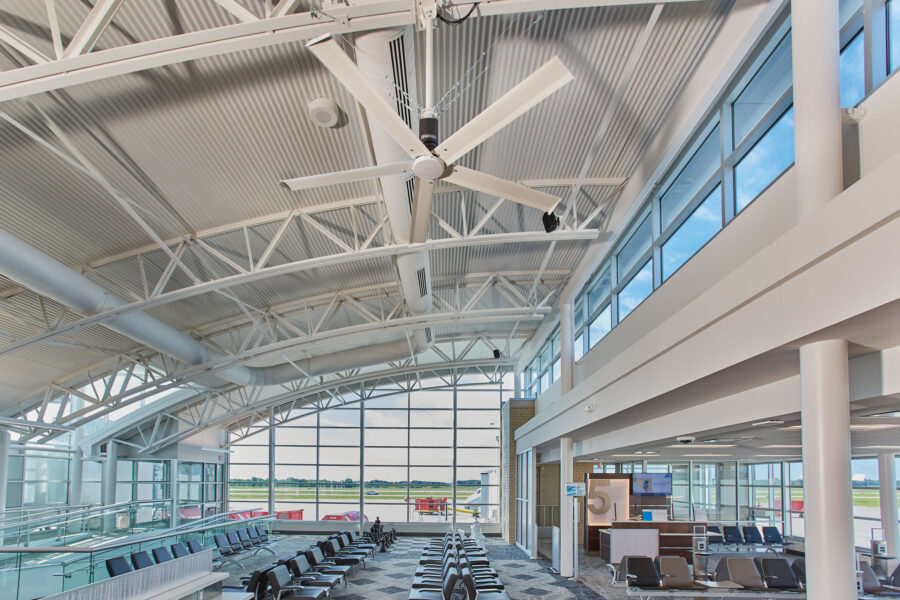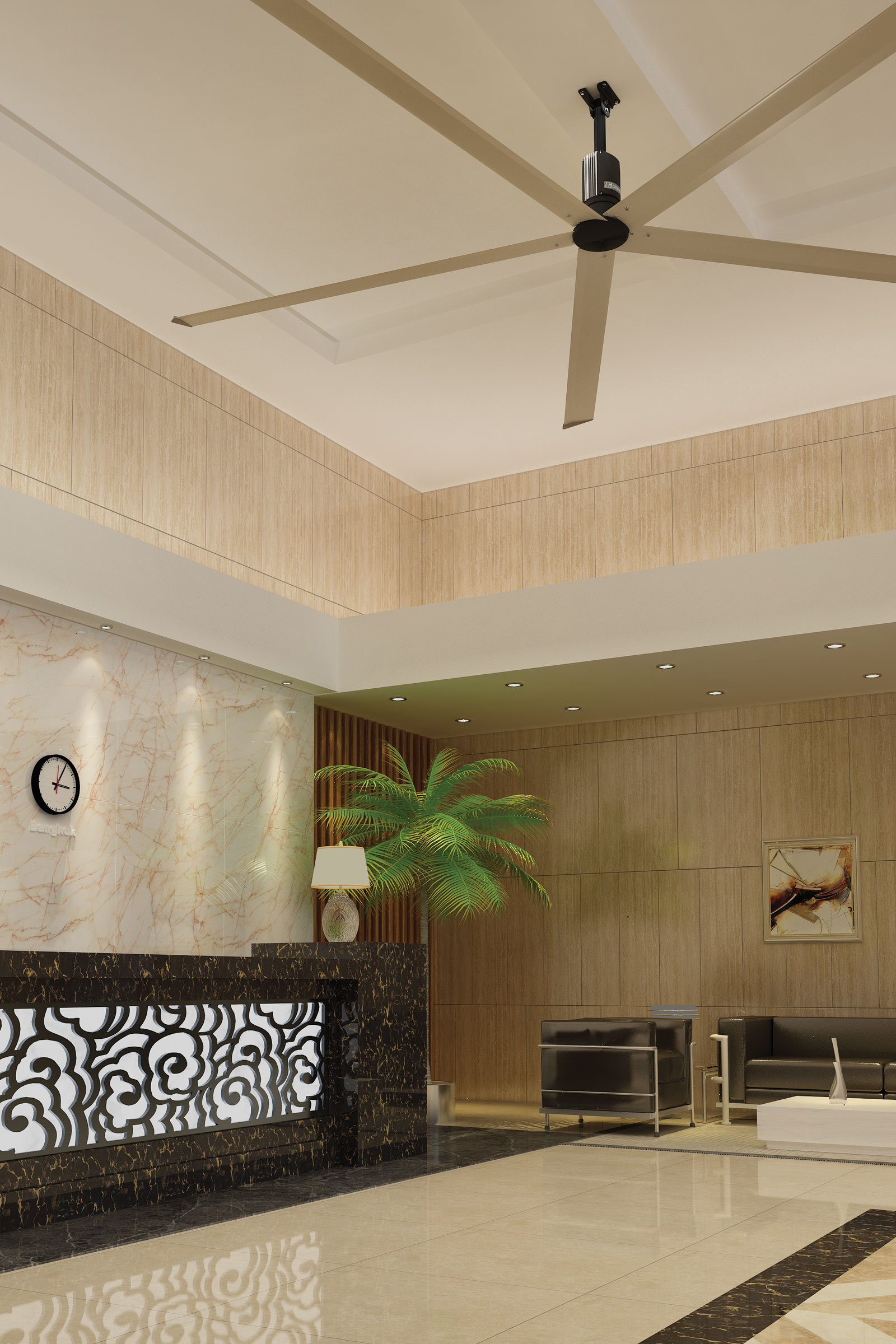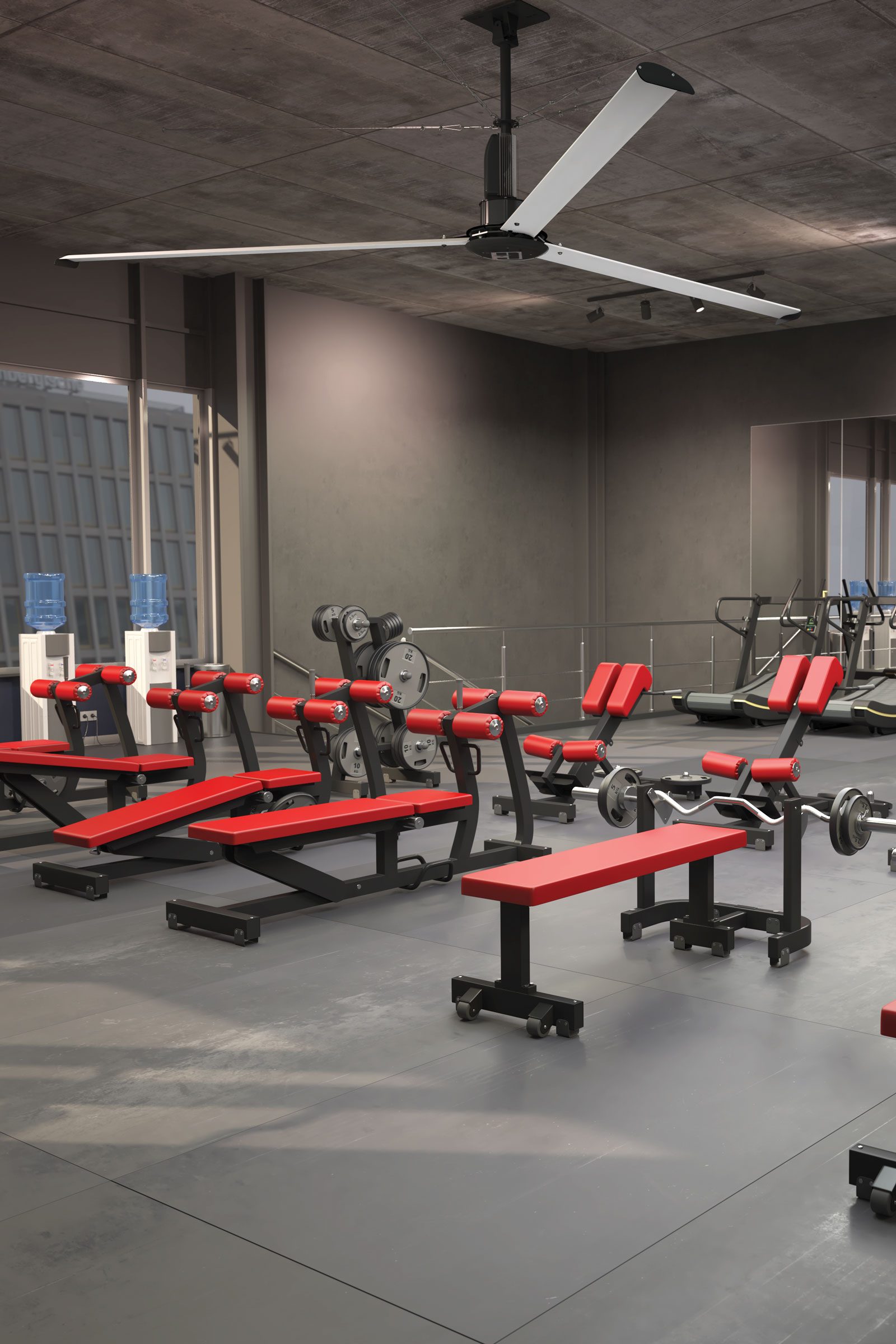Story at a glance:
- Overhead HVLS fans provide energy-efficient air circulation and evaporative cooling in commercial and industrial spaces.
- Numerous studies have shown that improved air movement and circulation contribute to better indoor air quality and occupant wellness.
In the quest to combat climate change, the building industry has increasingly put a great deal of focus on things like energy, building performance, resource conservation, and embodied carbon. But often design demands can distract from what’s perhaps most important—the people inside the buildings.
“Now more than ever, as we continue to weather and learn from conjoined public health, economic, social justice, and environmental crises, it has become increasingly apparent that we need to acknowledge the interrelationships between the wellness of people and the wellness of our planet,” says Heather Jauregui, director of sustainability and associate principal at Perkins Eastman. “Each of these has been influenced by the others, and the impact of climate change on all these crises cannot be overlooked. We cannot tackle these crises individually. We need to address all of them.”
It’s estimated that people spend about 90% of their lives indoors, and indoor air pollution is responsible for approximately 3.8 million deaths each year, according to the World Health Organization. Better airflow has a number of benefits. “Numerous studies have shown that improved air movement and circulation contribute to better indoor air quality and occupant wellness,” says Dan Tolles, HVLS product manager at Wisconsin-based Greenheck, a manufacturer of air movement, air control, air conditioning, and air distribution equipment. The company’s products are used in many types of buildings—including hospitals, office buildings, hotels, shopping malls, restaurants, schools, and industrial facilities.
“Research also indicates that occupant perception of indoor air quality and building comfort are heavily influenced by air movement. People tend to correlate increased airflow with better indoor air quality, and they generally report higher satisfaction with environmental comfort when they can feel air moving. In other words, humans tend to associate a breeze with fresh, outside air,” Tolles says. “How occupants perceive the comfort of an indoor environment can often be overlooked, but it’s another critical piece of high-performance building design.”

DS-3 is a powerful, lightweight, budget-friendly overhead fan designed to boost air comfort with less noise. Photo courtesy of Greenheck
Perception and performance are both essential goals. Air needs to move and be kept fresh in a manner that both preserves energy and offers comfort and assurance to occupants. An effective way to create optimum air movement is by using high-volume, low-speed (HVLS) fans. These are large-diameter, ceiling mounted axial fans that are meticulously designed to move large volumes of air at low speeds, utilizing minimal energy. Ideal in large, open spaces and originally designed for places like barns, warehouses, and manufacturing facilities, HVLS fans today are proving to be a powerful tool in many building types.
“Over the last 10 to 15 years we’ve seen a pretty dramatic increase in design professionals utilizing HVLS fans for commercial and institutional applications,” Tolles says. “Fans are being incorporated in a variety of building types like schools, retail stores, and fitness facilities because they’re an efficient way to provide elevated comfort in large spaces.”
- Photo courtesy of Greenheck
- Photo courtesy of Greenheck
Large, open indoor areas are traditionally very energy-intensive to heat and cool by utilizing standard HVAC and air movement methods alone. Adding an HVLS fan to the mix not only helps keep air moving in a healthy and comfortable manner, it can also contribute to significant energy savings.
“HVLS fans can counteract thermal stratification to both save on heating/cooling demands and create more comfortable environments through air movement,” Jauregui says. “By helping shift heat down to the occupant level during the winter and creating a light breeze in the summer to shift the perceived comfort zone, these fans can significantly save on energy demand for heating and cooling needs, particularly in larger spaces like gymnasiums.”
Utilizing little energy themselves, HVLS fans supplement building ventilation, so those systems don’t have to work as hard and expend as much energy. From blades to motors, the fans are thoughtfully designed for efficiency and airflow far superior to standard ceiling fans.
“To put it in perspective, most traditional ceiling fans provide airflow between 3,000 and 6,000 CFM. A single HVLS fan can provide airflow up to 250,000 CFM,” Tolles says. “Combine that level of air movement with high efficiency motor technology and the end result is an extremely efficient and effective product. For example, Greenheck uses a direct drive motor platform on our HVLS fans that consumes less than $1 per day in energy on average.”

Innovative HVLS fans support air movement that is effective, comfortable, and energy-efficient. Photo courtesy of Greenheck
In a truly holistic sustainable design, designers try to achieve multiple goals simultaneously. “It’s about wellness of people and wellness of the planet,” Jauregui says. “We like to zoom into design strategies that impact both sides of that equation. We focus on daylight, thermal comfort, acoustics, and air quality in our design process. Some of those are easy. For example, with daylighting, the better the natural light the less need you have for electric lighting, so the more energy you save. Others are more challenging. Better air quality can require increased ventilation as a strategy, which can increase energy. It’s about finding the right balance to get the best indoor air quality as efficiently as possible.”

These HVLS fans are engineered to meet the needs of most commercial and industrial spaces. Photo courtesy of Greenheck
Energy efficiency, building performance, health, and comfort may at times seem like opposing goals, but there are ways to bring them all together. HVLS fans may be one of them, as Greenheck says they’re an effective, low-energy way to support multiple objectives in a sustainable project.
“There is a misconception of HVLS fans being exclusively an agricultural or industrial product, but we believe every building on Earth could realize a benefit from using them,” Tolles says. “It’s not a one-size-fits-all technology, and there are different variations of fans for different purposes. Whether a building requires increased airflow to improve comfort or a means to reduce energy consumption, there’s an HVLS product to suit that need. At the end of the day, HVLS fans are designed to augment the rest of an HVAC system to deliver better building performance.”



